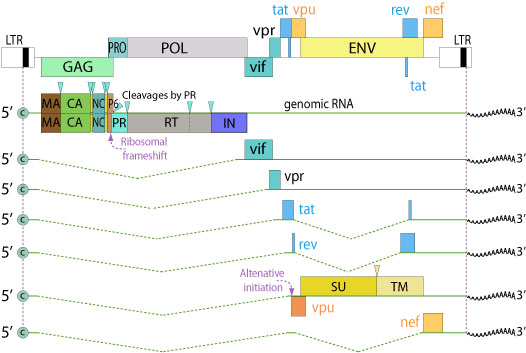HIV virus genome and proteins
Genome
Monopartite, linear, dimeric, ssRNA(+) genome of 9,75 kb, with a 5'-cap and a 3'poly-A tail. There are two long terminal repeats (LTRs) of about 600nt long at the 5' and 3' ends. The LTRs contain the U3, R, and U5 regions. There are also a primer binding site (PBS) at the 5'end and a polypurine tract (PPT) at the 3'end.
Transcription, splicing and proteins
The promoter elements in the 5' LTR control transcription by cellular DNA-directed RNA polymerase. The first polyA site in the R element is ignored, presumably because of the secondary RNA structure  . At the end of the viral mRNA, the presence of a U3 sequence upstream of R prevents this secondary structure, resulting in the polyA site being recognized to form the complete viral mRNA.
. At the end of the viral mRNA, the presence of a U3 sequence upstream of R prevents this secondary structure, resulting in the polyA site being recognized to form the complete viral mRNA.
Viral mRNA is then spliced: fully spliced mRNAs encode the accessory proteins Rev, Tat, and Nef.
Cellular processes prevent unspliced RNA from leaving the nucleus, but viral Rev allows export of incompletely or unspliced mRNA from the nucleus. Incompletely spliced mRNAs encode env, which is cleaved into the envelope proteins SU and TM and the accessory proteins vif, vpu, and vpr. Unspliced full-length mRNA serves as genomic RNA that is packaged into virions and/or as a template for translation of the gag and gag-(pro)pol polyproteins (ribosomal frameshift).


